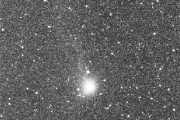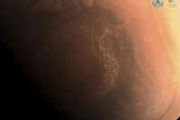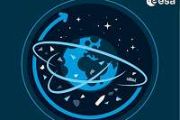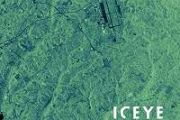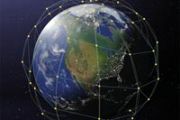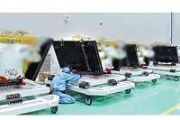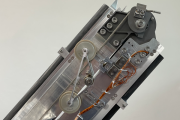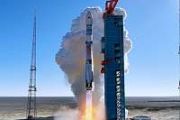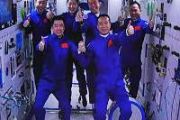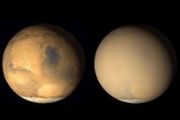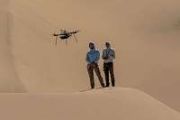
Copernical Team
China's space station to host 6 astronauts by end of 2022
 China's space station is expected to host six astronauts from two spaceships by the end of 2022, according to the chief designer of the country's manned space program.
The Shenzhou-13 crew has been in orbit for 140 days. They are in good health, and have so far completed all planned or added tasks as needed. They are expected to return to Earth in mid-April, Zhou Jianping said.
This
China's space station is expected to host six astronauts from two spaceships by the end of 2022, according to the chief designer of the country's manned space program.
The Shenzhou-13 crew has been in orbit for 140 days. They are in good health, and have so far completed all planned or added tasks as needed. They are expected to return to Earth in mid-April, Zhou Jianping said.
This NeoPhotonics offers ultra-narrow linewidth laser for LEO satellites
 NeoPhotonics Corporation (NYSE: NPTN), a leading developer of silicon photonics and advanced hybrid photonic integrated circuit-based lasers, modules and subsystems for bandwidth-intensive, high-speed communications networks, has announced its new Radiation Tolerant version of its industry leading Nano ultra-pure light tunable laser which has been designed for use in low earth orbit satellite co
NeoPhotonics Corporation (NYSE: NPTN), a leading developer of silicon photonics and advanced hybrid photonic integrated circuit-based lasers, modules and subsystems for bandwidth-intensive, high-speed communications networks, has announced its new Radiation Tolerant version of its industry leading Nano ultra-pure light tunable laser which has been designed for use in low earth orbit satellite co Detecting ultralight dark matter using quantum technology
 A new study led by Tel Aviv University researchers demonstrates unprecedented sensitivity to an exciting dark matter candidate. As part of the new NASDUCK ("Noble and Alkali Spin Detectors for Ultralight Coherent dark-matter") collaboration, the researchers developed unique innovative quantum technology that enables receiving more accurate information on invisible theoretical particles "suspecte
A new study led by Tel Aviv University researchers demonstrates unprecedented sensitivity to an exciting dark matter candidate. As part of the new NASDUCK ("Noble and Alkali Spin Detectors for Ultralight Coherent dark-matter") collaboration, the researchers developed unique innovative quantum technology that enables receiving more accurate information on invisible theoretical particles "suspecte Event horizons are tunable factories of quantum entanglement
 LSU physicists have leveraged quantum information theory techniques to reveal a mechanism for amplifying, or "stimulating," the production of entanglement in the Hawking effect in a controlled manner. Furthermore, these scientists propose a protocol for testing this idea in the laboratory using artificially produced event horizons. These results have been recently published in Physical Review Le
LSU physicists have leveraged quantum information theory techniques to reveal a mechanism for amplifying, or "stimulating," the production of entanglement in the Hawking effect in a controlled manner. Furthermore, these scientists propose a protocol for testing this idea in the laboratory using artificially produced event horizons. These results have been recently published in Physical Review Le Challenges await sample-return expedition to Mars
 Chinese scientists and engineers will need to solve a host of technological challenges to accomplish an ambitious sample-return mission to Mars, said Wu Weiren, a key figure in the country's deep-space exploration program and also a top political adviser.
A senior scientist with the China National Space Administration and academician of the Chinese Academy of Engineering, Wu said the missi
Chinese scientists and engineers will need to solve a host of technological challenges to accomplish an ambitious sample-return mission to Mars, said Wu Weiren, a key figure in the country's deep-space exploration program and also a top political adviser.
A senior scientist with the China National Space Administration and academician of the Chinese Academy of Engineering, Wu said the missi Probe to look for water on moon
 China plans to send its Chang'e 7 robotic probe to search for water and other resources at the moon's south pole, according to a leading space scientist.
"The Chang'e 7 mission is set to find traces of ice at the south pole, investigate the environment and weather there, and survey its landforms," said Wu Weiren, chief designer of China's lunar exploration program and an academician of the
China plans to send its Chang'e 7 robotic probe to search for water and other resources at the moon's south pole, according to a leading space scientist.
"The Chang'e 7 mission is set to find traces of ice at the south pole, investigate the environment and weather there, and survey its landforms," said Wu Weiren, chief designer of China's lunar exploration program and an academician of the NASA expands research into mining lunar ice, minerals to sustain humans on the moon
 NASA's desire to mine ice and minerals on the moon is driving new research on Earth into how astronauts could use moon materials to make machine parts, pave roads and construct living quarters. Scientists have studied lunar rocks brought back from Apollo missions, and NASA has confirmed the existence of water ice in craters on the moon's South Pole. University scholars and engineers at NASA are
NASA's desire to mine ice and minerals on the moon is driving new research on Earth into how astronauts could use moon materials to make machine parts, pave roads and construct living quarters. Scientists have studied lunar rocks brought back from Apollo missions, and NASA has confirmed the existence of water ice in craters on the moon's South Pole. University scholars and engineers at NASA are WashU scientists help recover gases from Moon rock time capsule
 St. Louis MO (SPX) Mar 08, 2022
Scientists from Washington University in St. Louis are helping to recover gases from a container of lunar soil that astronauts collected and sealed under vacuum on the surface of the Moon in 1972. The effort is part of NASA's Apollo Next Generation Sample Analysis (ANGSA) initiative.
Apollo 17 astronauts Harrison Schmitt and Eugene Cernan collected the samp
St. Louis MO (SPX) Mar 08, 2022
Scientists from Washington University in St. Louis are helping to recover gases from a container of lunar soil that astronauts collected and sealed under vacuum on the surface of the Moon in 1972. The effort is part of NASA's Apollo Next Generation Sample Analysis (ANGSA) initiative.
Apollo 17 astronauts Harrison Schmitt and Eugene Cernan collected the samp Hubble's Advanced Camera for Surveys celebrates 20 years of discovery

Today marks the 20th anniversary of the Advanced Camera for Surveys (ACS) aboard the NASA/ESA Hubble Space Telescope. On 7 March 2002 astronauts installed the ACS during Hubble Servicing Mission 3B, also known as STS-109. With its wide field of view, sharp image quality, and high sensitivity, the ACS delivers many of Hubble's most impressive images of deep space.
The ACS wavelength range extends from the ultraviolet, through the visible and out to the near-infrared. Its name, the Advanced Camera for Surveys, comes from its particular ability to map large areas of the sky in great detail. The ACS can also perform spectroscopy with a special optical tool called a grism.
Three subinstruments make up the ACS. The Wide Field Channel is a high-efficiency, wide-field, optical and near-infrared camera that is optimized to hunt for galaxies and galaxy clusters in the remote and ancient Universe, at a time when the cosmos was very young. The High Resolution Channel was designed to take extremely detailed (high resolution) pictures of the light from the centers of galaxies with massive black holes, though this is not currently operational, and the Solar Blind Channel blocks visible light to allow faint ultraviolet radiation to be discerned.
NASA's Psyche gets huge solar arrays for trip to metal-rich asteroid

With its solar arrays installed, the spacecraft is close to its final configuration ahead of a planned August launch.
NASA's Psyche mission is almost ready for its moment in the Sun—a 1.5-billion-mile (2.4-billion-kilometer) solar-powered journey to a mysterious, metal-rich asteroid of the same name. Twin solar arrays have been attached to the spacecraft body, unfolded lengthwise, and then restowed.







